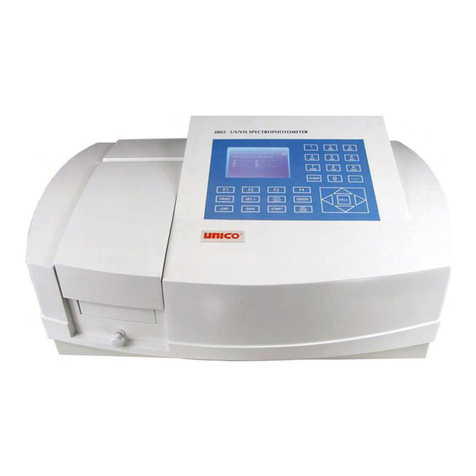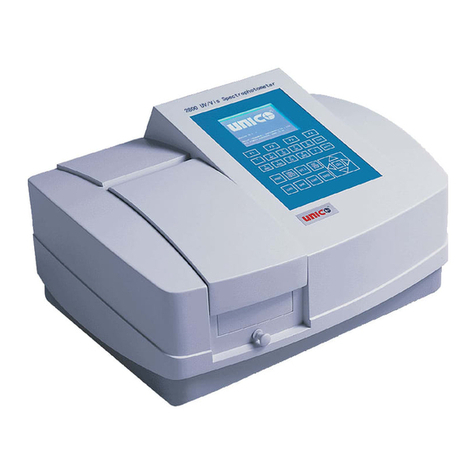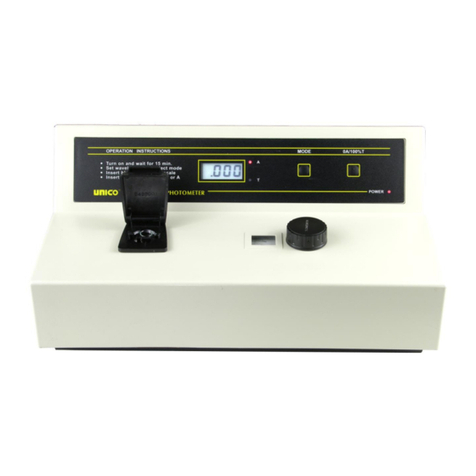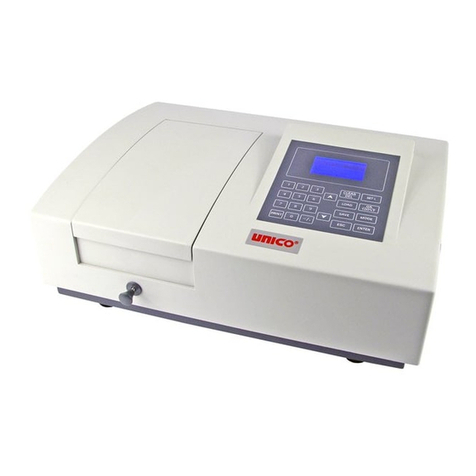
10
Holmium Oxide Filter Method
1. Turn instrument on and allow it to warm up for 15 minutes.
2. Select the Amode.
3. Set the wavelength to 350 nm.
4. Make sure the Cuvette Adapter is empty and place it in the Sample Compartment.
Close the lid.
5. Set zero Absorbance by pressing the ∧button. Wait a few seconds when the display
flashes. The reading should be 0.000A. If not, repeat step 5.
6. Remove the Cuvette Adapter and insert the Holmium filter into it. Place it in the
Sample Compartment again and close the lid.
7. Record the Absorbance reading on the Digital Display window.
8. Advance the wavelength setting by 1 nm and repeat step 4 to 7.
9. Repeat step 8 until the wavelength setting reaches 370 nm.
10.Look for the maximum absorbance reading obtained, and this should be found within
359~363 nm. The wavelength accuracy of the 1200 is ± 2 nm.
Didymium Filter Method
1. Set the Wavelength to 800 nm.
2. Make sure the cuvette adapter is empty and place it in the Sample Compartment.
Close the lid.
3. Set zero Abs by pressing the ∧button. Wait a few seconds when the display flashes.
The reading should then be 0.000A. If not, repeat step 3.
4. Remove the cuvette adapter and insert the Didymium filter into it. Place it in the
Sample Compartment again and close the lid.
5. Record the Absorbance reading on the Digital Display window.
6. Advance the wavelength setting by 1nm and repeat step 2 to 5.
7. Repeat step 6 until the wavelength setting reaches 815 nm.
8. Look for the maximum absorbance reading obtained, and this should be found within
805~809 nm. The wavelength accuracy of the 1200 is ± 2 nm.
9. If a “middle” wavelength check is desired, set the wavelength to 522 nm (optional)
10.Make sure the Cuvette Adapter is empty and place it in the Sample Compartment.
Close the lid.
11.Set zero Abs by pressing the ∧button. Wait a few seconds when the display flashes.
The reading should be 0.000A. If not repeat step 11.
12.Remove the Cuvette Adapter and insert the Didymium filter into it. Place it in the
Sample Compartment and close the lid.
13.Record the absorbance reading on the Digital Display window.
14.Advance the wavelength setting by 1 nm and repeat step 10 to 13.
15.Repeat step 14 until the wavelength setting reaches 536 nm. Again, look for the
maximum absorbance reading. It should be within 527~531 nm.
Absorbance Accuracy Check
Specification: ± 1% at 1A
The absorbance accuracy should be checked against a set of neutral density filters
accurately calibrated to the NIST standards. Contact your UNICO®representative for
more information (800-588-9776 or 732-274-1155).
































